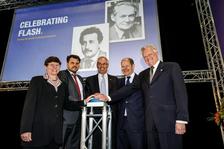"Celebrating FLASH" - In a symbolic ceremony, the two FLASH experimental halls were named after Nobel laureates Albert Einstein and Kai Siegbahn by Beatrix Vierkorn-Rudolph of the Federal Ministry of Research, the Swedish secretary of state Anders Lönn, DESY director Helmut Dosch, Hamburg's mayor Olaf Scholz and Hans Siegbahn, son of Kai Siegbahn (from left to right). (Credit: Lars Berg/DESY)
DESY opens new vistas into the nanocosm at its pioneering X-ray laser FLASH. A comprehensive technological upgrade and expansion of the facility enables entirely new experimental opportunities and opens up groundbreaking technologies to the international scientific community. At a symbolic ceremony, Olaf Scholz, First Mayor of Hamburg, and Anders Lönn, State Secretary to Sweden’s Minister for Higher Education and Research, named the two FLASH experimental halls after the pioneer physicists and Nobel Prize winners Albert Einstein and Kai Siegbahn. “The further technical refinement of our successful X-ray laser FLASH will now give researchers from all over the world even more precise insights into the nanocosm,” said the Chairman of DESY’s Board of Directors, Helmut Dosch.
In future, scientists will be able to peer into the nanocosm using FLASH at up to twelve different experimental stations, to make film recordings of chemical reactions, for instance, or to examine the dynamics of new types of data storage device, or to observe biomolecules at work. The research capacity of the X-ray laser is thereby being doubled. “The double FLASH is a further element by which the DESY Campus in Bahrenfeld is being expanded, turning it into one of the world’s leading sites for studying the structure of materials,” emphasised Scholz.
“We are greatly honoured that you chose to name one of the laboratory halls after the Swedish scientist Kai Siegbahn,” said Lönn. The Swedish-German cooperation in the framework of the Röntgen Ångström Cluster is not only bringing together world-class research in Germany and Sweden, Lönn emphasised. The comprehensive research infrastructures in the region are also very competitive in attracting high-tech industries.
“With the FLASH expansion new scientific territories are entered, creating research opportunities for completely new scientific experiments,” said Beatrix Vierkorn-Rudolph, representing the German Ministry for Education and Research. “These opportunities enable also new possibilities for cooperation with industry.”
FLASH delivers extremely short and intense X-rays flashes, which can be used to observe the ultra-fast processes taking place in the world of molecules and atoms. The facility is used by some 200 scientists from all over the world annually, but this is only a small fraction of the research proposals submitted. In the past three years, DESY has extended the facility for a cost of 33 million euros, adding a second laser line and a second experimental hall. In doing this, however, DESY is not just increasing the number of experimental stations available; the quality of the X-ray flashes has also been improved thanks to new technological developments, and the facility is more flexible too. In contrast to the original laser line, the wavelength of the X-rays on the new laser line can be altered during operation.
“There is a special relationship between Albert Einstein, Kai Siegbahn and the research carried out at FLASH,” said Dosch. “Einstein’s explanation of the photoelectric effect using the idea that light behaves like particles is what enables us to take a sort of chemical fingerprint of our samples.” 50 years later, the Swedish physicist Kai Siegbahn came up with photoelectron spectroscopy, a method that allows the chemical composition of samples to be unravelled. “This method has become an indispensible tool for material scientists, and is actually being developed further at FLASH as a way of studying ultra-fast processes,” said Dosch. “The choice of names emphasises the close and fruitful German-Swedish collaboration in research, which has been taken to a new level with the Röntgen Ångström Cluster.”







